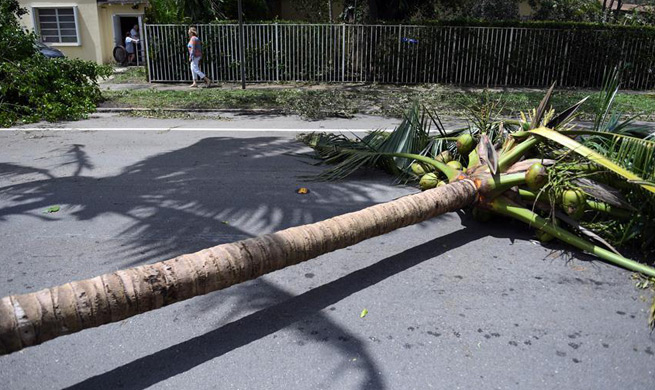HELSINKI, Sept. 12 (Xinhua) -- Europe was once proud of its welfare states, especially those in western and northern Europe. However, sluggish economic growth has trapped the governments in a financial dilemma.
Extravagant spending has now become a heavy burden despite repeated efforts to seek reforms.
In the aftermath of World War II, many European countries established comprehensive welfare systems, covering most aspects of people's lives.
An individual could enjoy various benefits, such as early education, basic education, housing, healthcare, unemployment support and pensions, among others. They were known as generous systems that provide welfare "from cradle to grave."
While the system enhanced social equality and provided a sound security net for decades, it has become difficult to finance it in recent years.
"No system is perfect," Juho Saari, professor of the University of Eastern Finland, told Xinhua. He believed the welfare states have been steadily adjusted to meet new requirements and are by and large doing well.
"It occasionally is evident, that our incentive systems do not perform satisfactorily, resulting in welfare dependency," said Saari, who has been entrusted by Finnish Prime Minister Juha Sipila to lead a working group tasked to halt increasing inequality.
ECONOMIC DOWNTURN
The European welfare systems were based on rapid economic growth and increasing tax revenues. They face a series of problems amid economic downturns.
In 2009, Greece, a member of the European Union (EU) with weak economic strength, suffered from the downgrading by the three major credit rating agencies owing to severe fiscal deficits and high debt levels, which led to the start of its sovereign debt crisis. The outbreak not only exposed the structural rigidness of the euro zone, but also warned of the risks of maintaining a giant welfare system. ( Since welfare expenditures are heavily dependent on good economic performance and a robust labor market, the increasing unemployment rate will lead to tax reduction and insufficient welfare spending.
From 2012 to 2014, for instance, the Finnish economy experienced negative growth for three consecutive years and became one of the worst performing economies in the EU. It was estimated by the then government that there would be a funding gap of 10 billion euros (12 billion U.S. dollars) for the welfare sector in the next 15 years.
The situation in Finland is not an exception. Quite a few European countries are facing an awkward situation in terms of maintaining social welfare. To Tackle the problem, the European countries have been trying to reform structures at both national and EU levels, with plenty of challenges lying ahead and a lack of fruitful results.
AGING SOCIETY
One of the biggest challenges is the end of the demographic dividend era. Saari said the dependency ratio has been a major risk imbedded in the welfare system. Since the European countries have "aging" societies, the labor force will have a bigger burden to support the non-labor.
Many European authorities are trying to extend the working life, reducing social support, encouraging the elderly to take care of themselves and calling on family members to partially shoulder the responsibility of supporting their senior relatives. The support of old people used to be a public task.
The influx of refugees has made the situation even worse. Since 2015, a large number of asylum seekers have been swarming into Europe from the Middle East. On humanitarian grounds, the host states provide them with basic support like healthcare, food, housing and basic education, no matter they have got the permission to stay or not.
Sweden, a Nordic country once boasted as a model of high-level welfare, received 163,000 refugees in 2015. Facing a crisis in housing, education and health care, the Swedish government had to change its policy from voluntary acceptance to mandatory assignment for municipalities.
Marten Blix, a researcher at the Research Institute of Industrial Economics, said the refugee crisis would impact the Swedish model.
Sweden has been among the countries with the world's highest salaries and wages, but many refugees have low education, poorly adapted to the labor market. "It's a very bad combination and the statistics speak its clear language," Blix said.
EXCESSIVE BENEFITS
In the process of institutionalization of the welfare systems, some economists kept warning against letting the excess benefits drift into solid demands.
Christophe Brochard, an economist at the University of Strasbourg, said in an interview with Xinhua that employees and entrepreneurs are "against each other to an extent that the sense of public interest has been lost."
Brochard also criticized the "intermediate bodies," which "are very powerful, defend their vested interest and lack the will to reform."
An analytical report conducted by the Organization for Economic Cooperation and Development (OECD) argued that Europe's generous welfare states, with their overprotective job security, high minimum wages and generous unemployment insurance, heavy taxation and their overriding emphasis on coordinated wage bargaining and social dialogue, had raised the costs of labor above market clearing levels. The OECD Jobs Strategy published in 1994 had examined the labor market performance of the welfare systems and suggested an overall reform to reduce the excessive benefits.
Obviously, the suggestion was merely a mission impossible in the European democratic society. "In terms of median voter, it is clear that you cannot win national elections with the anti-welfare state agenda," noted Saari.
Instead, Saari recommended flexicurity-models like those in Denmark. "A new welfare state model is likely to emerge and it shall probably consist of the elements of flexicurity-models, with labor market reforms, active labor market policy models, life-long learning and more pro-active social policies."

















